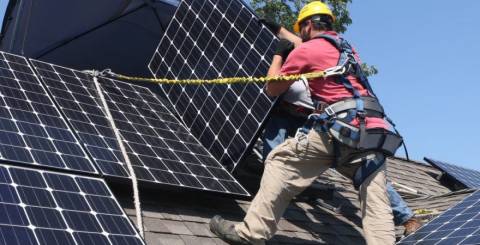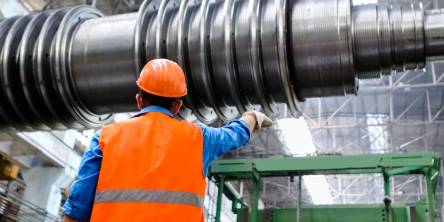What's Involved in a Solar Panel Installation

Solar panels are slowly being adopted by a lot of households and businesses in an effort to lower the cost of their electricity bills. Using solar panels is also a way to reduce the use of non-renewable fossil fuels that are slowly running out.
Before going into the specifics of solar panel installation, you have to understand what solar panels are and their advantages.
What is a solar panel?
A solar panel is a collection of solar cells or photovoltaic cells (PV cells) that convert solar energy into electricity. The more light that hits a solar panel, the more electricity it produces.
There are three kinds of solar panels - monocrystalline, polycrystalline, and thin film. The difference between them is the type of silicon used in the manufacturing process. As you may know, silicon is a type of semiconductor that is used in making wires and circuits. It is very helpful in transferring energy to different mediums. Silicon is taken from rocks when they are melted in a furnace using very high temperatures. Once they are melted, boron is put so that it adds a positive polarity because silicon alone is not enough to conduct electricity. After this process, the silicon cylinders are cut into wafers that are polished then put together on a panel.
What are the advantages of installing a solar panel?
It's already obvious that the first advantage of using a solar panel is decreasing the cost of electricity bills. Solar energy is free and all you need to harness that free energy is to buy a solar panel. Of course, solar panels are not as cheap as you think they are. However, with just a one-time purchase and installation of a solar panel, the benefits will outweigh your initial spending.
While you're saving on your electricity bills, you are also helping save the earth. Solar energy is renewable and it will continue to do so until the sun dies, which may not even happen at all. To add to that, you will contribute to lessening dependence on non-renewable sources that are gradually depleting and are also increasing in price because of the scarcity. One way to maximize the benefits of solar panels is by using a solar battery. A solar battery stores excess energy produced by your solar panels during the day, allowing you to use it when the sun is not shining. This helps reduce reliance on the grid and ensures you have backup power in case of outages.
Lastly, solar panels are low maintenance. Once a system is installed, it will require little maintenance and you can enjoy its benefits for many years. Some solar panel providers even give up to 25 years warranty so you don't have to worry about repairs.
Solar Panel Installation
And now for the meat of this article, which is all you need to know in solar panel installation.
The first time you inquire about a solar panel, your solar panel provider would ask you where you live. This is important because they will determine if it's worth having a solar panel because some places have less sunlight, so purchasing one wouldn't be practical.
Moreover, the size and the number of panels you will buy is dependent on how much electricity you use. Most of the time, you cannot rely purely on solar energy to supply all of your household's electricity needs. The most it can do is supply a good part of your electricity usage so that you pay for less electricity from your local electric company. To add to that, the space you have in your house is a factor in determining the size of the solar panel. This is because you might not have enough roof space where the panel will be installed. In all of these things, your provider will walk you through them.
Also, rooftops are a common place where solar panels are mounted, but they are not the only place where you could put them. If your room doesn't have enough space or does not receive enough sunlight, your solar panel can be mounted on the ground itself or on a shed that has a stable structure and receives more sunlight.
Once you have picked out and purchased a solar panel, it's time for installing them. If you've chosen a decent solar panel provider, installation is under them. But it's also important that you know how it goes.
First, up is making a mount. A mount is going to serve as the support or base of your solar panel and this will connect the panel to your roof. To do this, drill mounts four feet apart on each side. When drilling through your roof, make sure that you protect the holes with a sealant or a similar substance so you can prevent leaks from happening.
When the mounts are done, you can start making a conduit which is the channel that will act as a passageway of electricity from your panel to your home. Cover it up or tuck it underneath your roof.
After that, you can attach the solar panels to the mount. When fastening them, put several inches above the roof so that air can pass through. This is because airflow between the solar panel and the roof will increase the efficiency of the panel in converting energy.
Next up is installing the inverter. Inverters can be placed outdoors or indoors as long as they are close to the solar panel and they aren't exposed to too much heat. If your area is always sunny, then installing the inverter indoors is the best choice. When connecting the wiring of the panels, make sure that they are wired together instead of wiring them in groups or series. This step is more difficult than the others because it requires that you understand the wiring. The best choice for you is to hire an electrician, but you can also do it on your own as long as you understand how it works.
For the wiring, you can use a 6-gauge copper grounding wire that you would secure to the inverter. Make sure that the grounding wire connects to every section of the solar panel. Once done, you can make the connections from the solar panel to the conduit which relays the electricity to your home. You can use a nylon rope to make this easier.
After securing both the panel and inverter and connecting them through wires, you can also choose to install a monitoring system so that you can view how your solar panel is doing. Some system monitors are not hardware since they come in phone applications.
Similar Articles
Amazon Simple Queue Service (SQS), Simple Notification Service (SNS), and EventBridge are just a few of the messaging services that AWS provides to meet various demands when it comes to creating scalable and effective cloud systems.
Wearable technology, embracing devices small enough to be worn unobtrusively, constitutes a market that keeps expanding, and the momentum shows little sign of slowing
For job seekers, grasping the basic functions of Applicant Tracking Systems (ATS) is the first step in overcoming common job search barriers.
In the highly regulated world of pharmaceutical manufacturing, inventory management is far more than just tracking stock levels. It’s a critical component of ensuring product safety, quality, and compliance with current Good Manufacturing Practices (cGMP)
Find a reliable sealing technology with these 7 tips on quality, materials, certifications, and scalability to ensure lasting performance in your industry.
These days, your business depends on strong telecom systems and well-built software to stay ahead. Whether you’re launching a digital product or improving your communication tools, choosing the right team to work with makes a big difference.
Sometimes it seems like walking on a tight-rope when it comes to talking openly in team chats.
Learn how .NET Web API supports scalable architecture. Explore real-world best practices in .NET development for building high-performance, reliable endpoints.
Learn how to spot real fast USB-C charging by checking 4 key specs—output power, protocols, cable compatibility, and smart power distribution.









